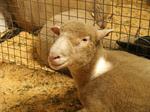Dairy Sheep – Sheep Milk Products - Boutique Industry
 Background
Background
Today’s agricultural market is undergoing a shift in its productive patterns. With the advent of “exotic” consumptive trends in “Western” societies, new niches have been created. Both the dairy sheep and goat industries are poised in a market that may provide unique growth opportunities. In continental Europe there is a strong tradition of dairy sheep production and many well known cheeses are made from ewe’s milk, for instance: pecorino, feta, manchego, romano, and roquefort. Worldwide, it is estimated that over 100 million sheep are used for milk production. France and Spain produce the largest quantities of sheep milk and sheep milk products.
Markets
The majority of sheep milk product is processed into cheese, with smaller quantities being used in yoghurt and ice cream production. Sheep milk butter is rarely seen and is considered by many to offer a potentially rich diversification opportunity. There is also a small market for liquid (or frozen milk) and for milk powder. Blended cow, sheep and goat milk cheeses hold the most promise in the specialty cheese market. The dairy sheep industry offers sheep producers an opportunity to diversify and value-add through local tourism, product and branding development, restaurants, and local food service and retail opportunities. As the industry grows there is scope for developing export markets.
Sheep Milk
Sheep milk has a higher solid content than cow or goat milk. This means that it is particularly suited to processing into cheese. The yield of cheese from goat or cow milk is usually around 1:10, whereas from sheep milk it is closer to 1:5 (meaning you get twice as much cheese per litre of liquid milk). The fat globules in sheep milk are also smaller than those in cow milk, making it more easily digestible. It also means that full fat sheep milk is suitable for freezing. In comparison with cows’ milk, it has higher levels of Vitamins A and E, and the minerals calcium, phosphorous, potassium, magnesium and zinc.
Breeds
Any milky ewe is capable of being a dairy sheep, but there are some breeds which are more commonly used. The East Friesian, British Milksheep and Dorsets (poll or horned) are the three breeds often encountered in dairy sheep herds. The Awassi and Lacaune are also popular milk sheep breeds.
Management
Although experience of rearing sheep for meat production will provide a helpful background, it is important to appreciate that dairying is a completely different venture which requires far more inputs, in terms of time and equipment, than meat production.
Dairy Sheep – Sheep Milk Products - Boutique Industry
Background
Today’s agricultural market is undergoing a shift in its productive patterns. With the advent of “exotic” consumptive trends in “Western” societies, new niches have been created. Both the dairy sheep and goat industries are poised in a market that may provide unique growth opportunities. In continental Europe there is a strong tradition of dairy sheep production and many well known cheeses are made from ewe’s milk, for instance: pecorino, feta, manchego, romano, and roquefort. Worldwide, it is estimated that over 100 million sheep are used for milk production. France and Spain produce the largest quantities of sheep milk and sheep milk products.
Markets
The majority of sheep milk product is processed into cheese, with smaller quantities being used in yoghurt and ice cream production. Sheep milk butter is rarely seen and is considered by many to offer a potentially rich diversification opportunity. There is also a small market for liquid (or frozen milk) and for milk powder. Blended cow, sheep and goat milk cheeses hold the most promise in the specialty cheese market. The dairy sheep industry offers sheep producers an opportunity to diversify and value-add through local tourism, product and branding development, restaurants, and local food service and retail opportunities. As the industry grows there is scope for developing export markets.
Sheep Milk
Sheep milk has a higher solid content than cow or goat milk. This means that it is particularly suited to processing into cheese. The yield of cheese from goat or cow milk is usually around 1:10, whereas from sheep milk it is closer to 1:5 (meaning you get twice as much cheese per litre of liquid milk). The fat globules in sheep milk are also smaller than those in cow milk, making it more easily digestible. It also means that full fat sheep milk is suitable for freezing. In comparison with cows’ milk, it has higher levels of Vitamins A and E, and the minerals calcium, phosphorous, potassium, magnesium and zinc.
Breeds
Any milky ewe is capable of being a dairy sheep, but there are some breeds which are more commonly used. The East Friesian, British Milksheep and Dorsets (poll or horned) are the three breeds often encountered in dairy sheep herds. The Awassi and Lacaune are also popular milk sheep breeds.
Management
Although experience of rearing sheep for meat production will provide a helpful background, it is important to appreciate that dairying is a completely different venture which requires far more inputs, in terms of time and equipment, than meat production.
If you are interested in Sheep Husbandry and want to learn more - we recommend Sheep Husbandry BAG210 or get some advise/information from our tutors - Course Advice
More from ACS
Explore the distinguishing characteristics of different diseases, and understand how they affect animals.
